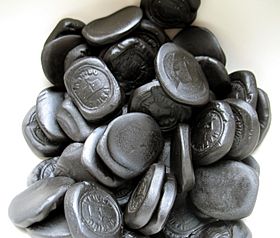Pontefract cake facts for kids

A pile of Pontefract cakes
|
|
| Alternative names | Pomfret cake, Pomfrey cake |
|---|---|
| Type | Confectionery |
| Place of origin | United Kingdom |
| Region or state | Yorkshire |
| Main ingredients | Liquorice |
Pontefract cakes are small, round, black sweets. They are made from liquorice and are about 2 centimeters (3/4 inch) wide. These tasty treats were first made in the town of Pontefract in Yorkshire, England. They are also sometimes called Pomfret cakes or Pomfrey cakes.
Contents
What's in a Name? Pontefract Cakes
The first name for these small liquorice sweets was "Pomfret cake." This name came from an old Norman name for the town of Pontefract. However, people don't use that name much anymore. Now, they are almost always called "Pontefract cakes." The word "cake" itself has a long history. It comes from an old Germanic word meaning "to cook."
The Sweet History of Liquorice
The exact start of liquorice growing in England is not fully known. But by the 1500s, people were definitely growing it. It might have started in gardens at monasteries or big houses. In the 1600s, liquorice was grown in areas with special soil. These places included Surrey, Lincolnshire, Nottinghamshire, and Yorkshire.
Pontefract's Special Role
By the late 1700s, most liquorice growing was happening in Pontefract. It was also grown in Surrey, near Godalming. In Pontefract, people grew liquorice in small plots behind their homes. An old map from 1648 shows liquorice growing in "garths," which are like small gardens.
From Medicine to Sweet Treat
In the 1700s, liquorice was mostly used as a medicine. It helped both people and horses. The Pontefract cake was likely a black lozenge. It was used to make "liquorish water" for health. These cakes were stamped with a special castle symbol. This symbol showed that they were good quality. This trademark has been used on Pontefract cakes since 1612.
It was not until the 1800s that liquorice became a popular sweet. A chemist named George Dunhill was very important. In 1760, he added sugar to the medicinal liquorice. He also grew liquorice himself. As Pontefract cakes became popular sweets, more liquorice was needed. Local growers could not supply enough. By the late 1800s, most liquorice for sweets came from places like Turkey.
How Pontefract Cakes Are Made
At first, these sweets were stamped by hand to create their traditional look. The workers who did this were called "cakers." They could make over 30,000 cakes each day! Today, machines usually make them.
The Famous Castle Design
The stamp on the cakes was a picture of Pontefract Castle. It often had a raven bird on top. This design has been used for almost 400 years. A special Pontefract cake stamp was even used in 1872. It sealed the ballot box for the first secret ballot (private vote) in the United Kingdom. This stamp showed a castle and an owl.
Eating Pontefract Cakes Safely
Pontefract cakes are a delicious treat. However, like any sweet, it's best to eat them in moderation. Eating too much liquorice can sometimes cause problems. In 2004, doctors warned that eating a very large amount daily could lead to health issues. This is because liquorice contains a substance called glycyrrhizic acid. Eating too much of it can lower potassium levels in the body. So, enjoy your Pontefract cakes, but remember that a little goes a long way!

